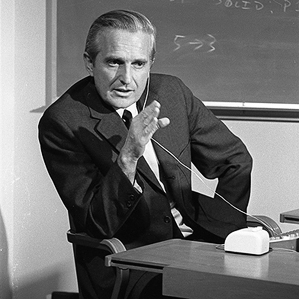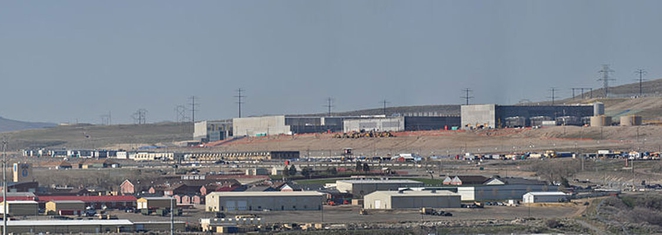Tuesday, August 27. 2013
Douglas Engelbart’s Unfinished Revolution
-----
Computing pioneer Doug Engelbart’s inventions transformed computing, but he intended them to transform humans.

Peripheral vision: Engelbart rehearses for the “mother of all demos.”
Doug Engelbart knew that his obituaries would laud him as “Inventor of the Mouse.” I can see him smiling wistfully, ironically, at the thought. The mouse was such a small part of what Engelbart invented.
We now live in a world where people edit text on screens, command computers by pointing and clicking, communicate via audio-video and screen-sharing, and use hyperlinks to navigate through knowledge—all ideas that Engelbart’s Augmentation Research Center at Stanford Research Institute (SRI) invented in the 1960s. But Engelbart never got support for the larger part of what he wanted to build, even decades later when he finally got recognition for his achievements. When Stanford honored Engelbart with a two-day symposium in 2008, they called it “The Unfinished Revolution.”
To Engelbart, computers, interfaces, and networks were means to a more important end—amplifying human intelligence to help us survive in the world we’ve created. He listed the end results of boosting what he called “collective IQ” in a 1962 paper, Augmenting Human Intellect. They included “more-rapid comprehension … better solutions, and the possibility of finding solutions to problems that before seemed insoluble.” If you want to understand where today’s information technologies came from, and where they might go, the paper still makes good reading.
Engelbart’s vision for more capable humans, enabled by electronic computers, came to him in 1945, after reading inventor and wartime research director Vannevar Bush’s Atlantic Monthly article “As We May Think.” Bush wrote: “The summation of human experience is being expanded at a prodigious rate, and the means we use for threading through the consequent maze to the momentarily important item is the same as was used in the days of square-rigged ships.”
That inspired Engelbart, a young electrical engineer, to come up with the idea of people using screens and computers to collaboratively solve problems. He worked on his ideas for the rest of his life, despite being warned over and over by people in academia and the computer industry that his ideas of using computers for anything other than scientific computations or business data processing was “crazy” and “science fiction.”
Englebart knew right from the start that screens, input devices, hardware, and software could allow the necessary collaborative problem-solving only as part of a system that included cognitive, social, and institutional changes. But he found introducing new ways for people to work together more effectively, the lynchpin of his overall vision, more difficult than transforming the way humans and computers interact.
Engelbart labored for most of his life and career to get anyone to think seriously about his ideas, of which the mouse was an essential but low-level component. Only for one golden decade did he get significant backing. In 1963, the U.S. Defense Department provided the wherewithal for Engelbart to assemble a team, create the future, and blow the mind of every computer designer in the world by way of what has come to be known as “the mother of all demos.”
I first met Engelbart in 1983 in his Cupertino office in a small building that was completely surrounded by the Apple campus. A company that no longer exists, Tymshare, had purchased what was left of Engelbart’s lab and hired him after the Stanford Research Institute stopped supporting the Augmentation Research Center due to the Department of Defense withdrawing funding.
Engelbart noted with dismay that although the personal computer was evolving quickly, the other elements of his plan weren’t. At the time, personal computers weren’t networked to one another—as terminals of large computers could be at the time—and they lacked a mouse or point-and-click interface.
Engelbart told me in our first conversation, as I’m sure he must have told many others, that the computer and mouse were just the “artifacts” in a system that centered on “humans, using language, artifacts, methodology, and training.”
In the late 1980s, Engelbart set up his self-funded “Bootstrap Institute” to try and get his ideas about working more effectively the acceptance his artifacts had. He developed ways of analyzing how people acted inside an organization and specific techniques that he claimed would boost “collective IQ.” A set of detailed presentations on those methodologies started with what he called CODIAK. “Collective IQ is a measure of how effectively a collection of people can concurrently develop, integrate, and apply its knowledge toward its mission,” (emphasis Engelbart’s).
Mouse manufacturer Logitech provided office space, but the Bootstrap Institute – staffed by Engelbart and his daughter Christina—never sold bootstrapping, collective IQ, or CODIAK to any funder, major company, or government department.
Engelbart’s failure to spread the less tangible parts of his vision stems from several circumstances. He was an engineer at heart, and engineers’ utopian solutions don’t always account for the complexities of human social institutions. He only added a social scientist to his lab just before it was shut down.
What’s more, Engelbart’s pitches of linked leaps in technology and organizational behaviors probably sounded as crazy to 1980s corporate managers as augmenting human intellect with machines did in the early 1960s. In the end, the way Silicon Valley companies work changed radically in recent decades not through established companies going through the kind of internal transformations Engelbart imagined, but by their being displaced by radical new startups.
When I talked with him again in the mid-2000s, Engelbart marveled that people carry around in their pockets millions of times more computer power than his entire lab had in the 1960s, but the less tangible parts of his system had still not evolved so spectacularly.
Like Tim Berners-Lee, Engelbart never sought to own what he contributed to the world’s ability to know. But he was frustrated to the end by the way so many people had adopted, developed, and profited from the digital media he had helped create, while failing to pursue the important tasks he had created them to do.
Howard Rheingold, a visiting lecturer at Stanford University, has written since the early 1980s about how innovations in computers and networking change peoples’ thinking. He profiled Doug Engelbart’s work in his 1985 book, Tools for Thought and is most recently author of Net Smart: How to Thrive Online.
Monday, August 12. 2013
Nicolas Feldmeyer photography
... and now, the blog will slow down for some time while I'll go in the mountains & somewhere in the Atlantic! Or both, the moutains in the Atlantic.
Via Fubiz
-----

Related Links:
Pour un "habeas corpus" numérique, Eric Sadin
Via ericsadin.org via Le Monde
-----
Following all these recent posts aboutths nsa, algorithms, surveillance/monitoring, etc., I take here the opportunity to reblog what our very good friend Eric Sadin published in Le Monde last month about this question (the article is only in French, it was following the publication of a new book by Eric: L'humanité augmentée - L'administration numérique du monde -, éd. L'échapée). It is also the occasion to remind that we did a work in common about this last year, Globale surveillance, that will be on stage again later this year!

Le 5 juin, Glenn Greenwald, chroniqueur au quotidien britannique The Guardian, révèle sur son blog que l'Agence de sécurité nationale (NSA) américaine bénéficie d'un accès illimité aux données de Verizon, un des principaux opérateurs téléphoniques et fournisseurs d'accès Internet américains. La copie de la décision de justice confidentielle est publiée, attestant de l'obligation imposée à l'entreprise de fournir les relevés détaillés des appels de ses abonnés. "Ce document démontre pour la première fois que, sous l'administration Obama, les données de communication de millions de citoyens sont collectées sans distinction et en masse, qu'ils soient ou non suspects", commente-t-il sur la même page.
Dès le lendemain, Glenn Greenwald relate dans un article cosigné avec un journaliste du Guardian d'autres faits décisifs : neuf des plus grands acteurs américains d'Internet (Google, Facebook, Microsoft, Apple, Yahoo, AOL, YouTube, Skype et PalTalk) permettraient au FBI (la police fédérale) et à la NSA d'avoir directement accès aux données de leurs utilisateurs, par le biais d'un système hautement sophistiqué baptisé "Prism", dont l'usage régulier serait à l'oeuvre depuis 2007. Informations confidentielles à l'origine livrées par Edward
Snowden, jeune informaticien ex-employé de l'Agence centrale du renseignement (CIA), officiant pour différents sous-traitants de la NSA. Le "lanceur d'alerte" affirme que de telles pratiques mettent en péril la vie privée, engageant en toute conscience son devoir de citoyen de les divulguer, malgré les risques de poursuites encourues. Les entreprises incriminées ont aussitôt démenti cette version, laissant néanmoins supposer que des négociations sont en cours en vue de créer un cadre coopératif "viable" élaboré d'un commun accord.
Divulgations qui ont aussitôt suscité un afflux de commentaires de tous ordres, relatifs à l'ampleur des informations interceptées par les agences de renseignement, autant qu'à l'impérieuse nécessité de préserver les libertés individuelles.
S'il demeure de nombreuses zones d'ombre et des incertitudes quant aux procédés employés et à l'implication de chacun des acteurs, ces affaires confirment manifestement, aux yeux du monde, qu'un des enjeux cruciaux actuels renvoie à l'épineuse question de la récolte et de l'usage des données à caractère personnel. Ces événements, s'ils sont confirmés dans leur version initiale, sont éminemment répréhensibles, néanmoins, pour ma part, je ne veux y voir qu'une forme de "banalité de la surveillance contemporaine", qui dans les faits se déploie à tout instant, en tout lieu et sous diverses formes, la plupart du temps favorisée par notre propre consentement.
Car ce qui se joue ici ne relève pas de faits isolés, principalement "localisés" aux Etats-Unis et conduits par de seules instances gouvernementales, dont il faudrait s'offusquer au rythme des révélations successives. C'est dans leur valeur symptomale qu'ils doivent être saisis, en tant qu'exemples de phénomènes aujourd'hui globalisés, rendus possibles par la conjonction de trois facteurs hétérogènes et concomitants. Sorte de "bouillon de culture" qui se serait formé vers le début de la première décennie du XXIe siècle, et qui a "autorisé" l'extension sans cesse croissante de procédures de surveillance, suivant une ampleur et une profondeur sans commune mesure historique.
D'abord, c'est l'expansion ininterrompue du numérique depuis le début des années 1980, plus tard croisée aux réseaux de télécommunication, qui a rendu possible vers le milieu des années 1990 la généralisation d'Internet, soit l'interconnexion globalisée en temps réel.
Ensuite, l'intensification de la concurrence économique a encouragé l'instauration de stratégies marketing agressives, cherchant à capter et à pénétrer toujours plus profondément les comportements des consommateurs, un objectif facilité par la dissémination croissante de données grâce au suivi des navigations, ou autres achats par cartes de crédit ou de fidélisation.
Enfin, les événements du 11 septembre 2001 ont contribué à amplifier un profilage sécuritaire indifférencié du plus grand nombre d'individus possible. Ce qui est désormais nommé " Big Data ", soit la profusion de données disséminées par les corps et les choses, se substitue en quelque sorte à la figure unique et omnipotente de Big Brother, en une fragmentation éparpillée de serveurs et d'organismes, qui concourent ensemble et séparément à affiner la connaissance des personnes, en vue d'une multiplicité de fonctionnalités à exploitations prioritairement sécuritaires ou commerciales.
Le lien charnel, tactile ou quasi ombilical que nous entretenons avec nos prothèses numériques miniaturisées - particulièrement emblématique dans le smartphone - bouleverse les conditions historiques de l'expérience humaine. La géolocalisation intégrée aux dispositifs transforme ou "élargit" notre appréhension sensorielle de l'espace ; la portabilité expose une forme d'ubiquité induisant une perception de la durée au rythme de la vitesse des flux électroniques reçus et transmis ; les applications traitent des magmas d'informations à des vitesses infiniment supérieures à celles de nos capacités cérébrales, et sont dotées de miraculeux pouvoirs cognitifs et suggestifs, qui peu à peu infléchissent la courbe de nos quotidiens.
C'est un nouveau mode d'intelligibilité du réel qui s'est peu à peu constitué, fondé sur une transparence généralisée, qui réduit la part de vide séparant les êtres entre eux et les êtres aux choses. "Tournant numérico-cognitif" engendré par l'intelligence croissante acquise par la technique, capable d'évaluer les situations, d'alerter, de suggérer et de prendre dorénavant des décisions à notre place (à l'instar du récent prototype de la Google Car, ou du trading à haute fréquence).
Le mouvement généralisé de numérisation du monde, dont Google constitue le levier principal, vise à instaurer une "rationalisation algorithmique de l'existence", à redoubler le réel logé au sein de "fermes de serveurs" hautement sécurisées, en vue de le quantifier et de l'orienter en continu à des fins d'"optimisation" sécuritaire, commerciale, thérapeutique ou relationnelle. C'est une rupture anthropologique qui actuellement se trame par le fait de notre condition de toute part interconnectée et robotiquement assistée, qui s'est déployée avec une telle rapidité qu'elle nous a empêchés d'en saisir la portée civilisationnelle.
Les récentes révélations mettent en lumière un enjeu crucial de notre temps, auquel nos sociétés dans leur ensemble doivent se confronter activement, devant engager à mon sens trois impératifs éthiques catégoriques. Le premier consiste à élaborer des lois viables à échelles nationale et internationale, visant à marquer des limites, et à rendre autant que possible transparents les processus à l'oeuvre, souvent dérobés à notre perception.
Dimensions complexes dans la mesure où les développements techniques et les logiques économiques se déploient suivant des vitesses qui dépassent celle de la délibération démocratique, et ensuite parce que les rapports de force géopolitiques tendent à ralentir ou à freiner toute velléité d'harmonisation transnationale (voir à ce sujet la récente offensive de lobbying américain cherchant à contrarier ou à empêcher la mise en place d'un projet visant à améliorer la protection des données personnelles des Européens : The Data Protection Regulation - DPR - ).
Le deuxième requiert un devoir d'enseignement et d'apprentissage des disciplines informatiques à l'école et à l'université, visant à faire comprendre "de l'intérieur" les fonctionnements complexes du code, des algorithmes et des systèmes. Disposition susceptible de positionner chaque citoyen comme un artisan actif de sa vie numérique, à l'instar de certains hackeurs qui en appellent à comprendre les processus à l'oeuvre, à se réapproprier les dispositifs ou à en inventer de singuliers, en vue d'usages "libres" et partagés en toute connaissance des choses.
Le troisième mobilise l'enjeu capital visant à maintenir une forme de "veille mutualisée" à l'égard des protocoles et de nos pratiques, grâce à des initiatives citoyennes s'emparant sous de multiples formes de ces questions, afin de les exposer dans le domaine public au fur et à mesure des évolutions et innovations successives. Nous devons espérer que l'admirable courage d'Edward Snowden ou la remarquable ténacité de Glenn Greenwald soient annonciateurs d'un "printemps globalisé", appelé à faire fleurir de toute part et pour le meilleur les champs de nos consciences individuelles et collectives.
Citons les propos énoncés par Barack Obama lors de sa conférence de presse du 7 juin : "Je pense qu'il est important de reconnaître que vous ne pouvez pas avoir 100 % de sécurité, mais aussi 100 % de respect de la vie privée et zéro inconvénient. Vous savez, nous allons devoir faire des choix de société." Dont acte, et sans plus tarder.
A l'aune de l'incorporation annoncée de puces électroniques à l'intérieur de nos tissus biologiques, qui témoignerait alors sans rupture spatio-temporelle de l'intégralité de nos gestes et de la nature de nos relations, la mise en place d'un "Habeas corpus numérique" relève à coup sûr d'un enjeu civilisationnel majeur de notre temps.
Eric Sadin
© Le Monde
Wednesday, August 07. 2013
Massive NSA data center will use 1.7 million gallons of water a day
Via Treehugger
-----
By Megan Treacy

Undeniably one of the biggest stories of the year has been the leak about the NSA PRISM program, which has been monitoring American citizens' communications. Many people have been appalled by this revelation, but it turns out there is an environmentally appalling part of this spying program too. More details have been released about NSA's new Intelligence Community Comprehensive National Cybersecurity Initiative Data Center, otherwise known as that massive data center being built by the agency in Bluffdale, Utah.
Turns out that collecting tons of information in the form of phone calls, emails and web searches is an energy and water-hungry business. According to reports, the one million square-foot facility will house 100,000 square feet of data-storing servers and will use 1.7 million gallons of water per day to keep those servers cool.
The data center will account for one percent of all water use in the area and the city of Bluffdale is looking for additional water sources for when the facility is finished in September.
It won't be an energy-sipper either, but that was obvious from the size of the place. The facility will require 65 megawatts of power, which is the equivalent of 65,000 homes. It will have its own power substation and back-up diesel power generators.
The crazy thing is that this gigantic data center isn't quite enough. The NSA is also building another data center in Fort Meade, Maryland that will be two-thirds the size of the mega center, but that's still pretty darn big.
fabric | rblg
This blog is the survey website of fabric | ch - studio for architecture, interaction and research.
We curate and reblog articles, researches, writings, exhibitions and projects that we notice and find interesting during our everyday practice and readings.
Most articles concern the intertwined fields of architecture, territory, art, interaction design, thinking and science. From time to time, we also publish documentation about our own work and research, immersed among these related resources and inspirations.
This website is used by fabric | ch as archive, references and resources. It is shared with all those interested in the same topics as we are, in the hope that they will also find valuable references and content in it.
Quicksearch
Categories
Calendar
|
|
August '13 |
|
||||
| Mon | Tue | Wed | Thu | Fri | Sat | Sun |
| 1 | 2 | 3 | 4 | |||
| 5 | 6 | 7 | 8 | 9 | 10 | 11 |
| 12 | 13 | 14 | 15 | 16 | 17 | 18 |
| 19 | 20 | 21 | 22 | 23 | 24 | 25 |
| 26 | 27 | 28 | 29 | 30 | 31 | |
